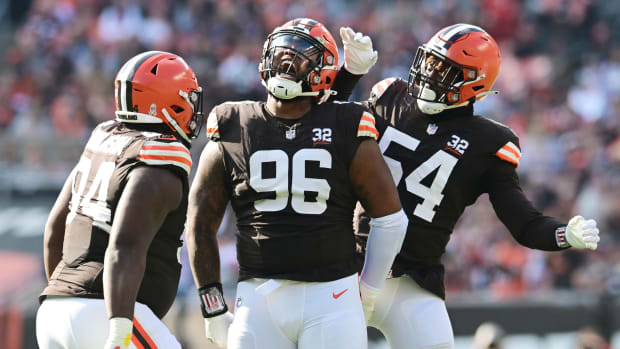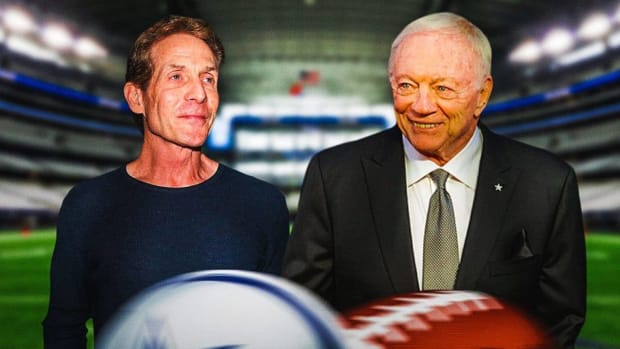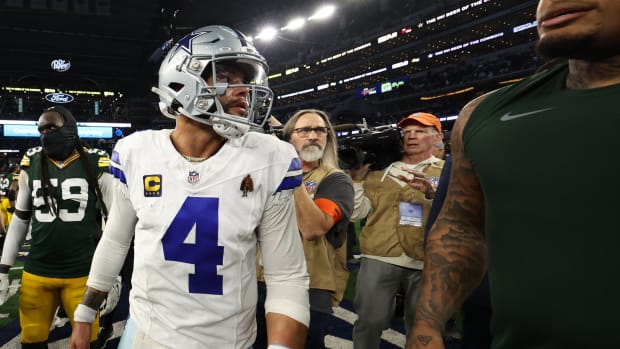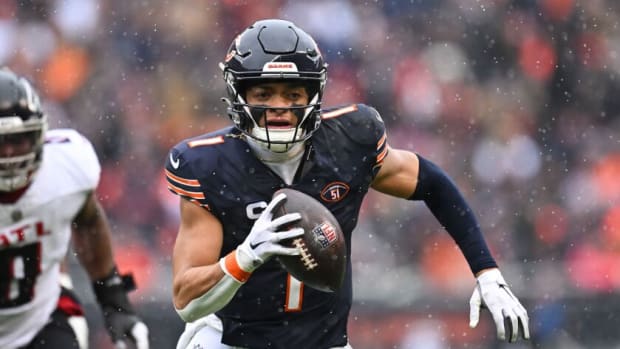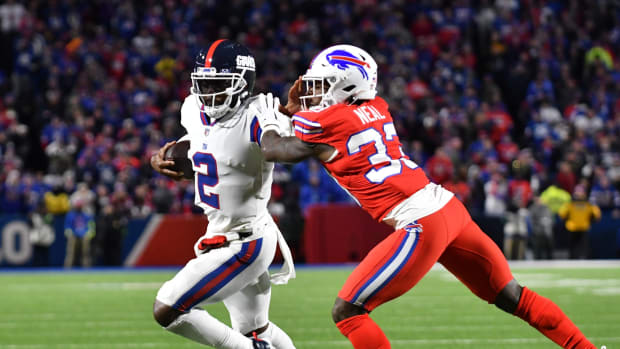"What's the Next Thing?" Matt Nagy, Bears Focused on Staying a Step Ahead
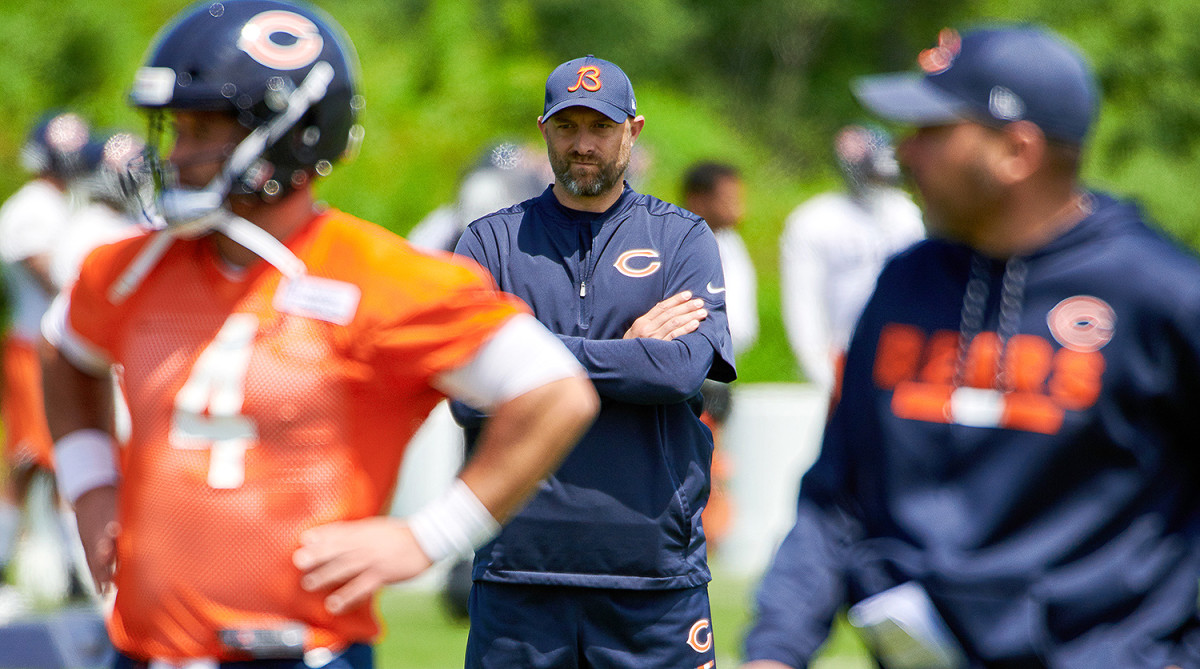
BOURBONNAIS, Ill. — Bears GM Ryan Pace would catch new head coach Matt Nagy in the run-up to the draft scribbling notes with a pen on a notepad about this player or that player—the kind of scene you might see in any coach’s office during any day in April.
What caught Pace’s attention back then, though, wasn’t what he had written on that particular notepad. It was what was going on a second one, right next to it.
“We’re going through the college evaluation process, and I’m giving him guys, and for the first time, he’s watching defensive backs and linebackers,” Pace said, a few minutes before Chicago’s first full-squad workout of 2018 training camp. “But I love the fact that I go into his office and there’s this second notepad, equally filled out, with all the plays he likes that he’s seeing. He’s taking from everyone.
“That open-mindedness is really cool to see.”
The Bears and Ravens have officially kicked off training camp, and by this time next week the other 30 teams will be well underway too. And there’s no lack of storylines going in—Aaron Rodgers, J.J. Watt, Deshaun Watson, Odell Beckham, Andrew Luck, Julian Edelman, Ryan Tannehill and David Johnson are back from injury; Kirk Cousins and Case Keenum are with new teams; there are five first-round QBs to watch; the Patriots’ drama still needs sorting out; and the champion Eagles headline a loaded NFC, just to name a few.
But there’s one you shouldn’t miss—and might if you’re not looking—that centers on that term Pace used to describe his new coach’s approach: open-mindedness.
The 2017 NFL season began with Kansas City ripping through New England using an attack straight out of Saturday. Nagy coordinated that Chiefs offense. Last year ended with the Eagles outflanking those same Patriots with another spread/West Coast hybrid, fueled by RPOs (run-pass options, for the uninitiated), movement and a bevy of formationing. Nagy’s predecessor in K.C., Doug Pederson, helmed that one.
Now, Nagy is running his own show, and you can imagine what it looks like on the fields of Olivet Nazarene’s campus. Almost every snap is out of the gun. Pre-snap movement is constant. The quarterback seems to be deployed as a threat in multiple ways on each play. If it kind of looks like college football, that’s O.K., even if it didn’t used to be at this level.
The Eagles’ Brotherhood of Blockers
Coming into this NFL season, the biggest story I see is born of that open-mindedness Pace talked about: coaches embracing ideas from all levels of football. I can’t remember a season where I was more looking forward to seeing what coaches are going to bring offensively—and that’s because a league that once thumbed its nose at these sorts of concepts is feverishly incorporating them. Which brings us back to Nagy’s notepad.
“Well, I just put new plays on the front of the pad,” Nagy said. “So it’s just new plays, and you can flip through it. If I ever feel like we need a little more creativity, or if there’s something I like, without studying it, I’ll just tag it, I’ll draw it up, and I have it—whatever game it is, college, NFL. … I’m an out-of-the-box guy. I really am. I don’t why. I always have been.
“Something that’s new, that’s different, that’s creative, that’s fun, it’s challenging to the defense if they haven’t seen it before. Any advantage you can get as a play-caller or a play-designer, you want that. These coaches out there, however you flip it, we all watch a lot of tape, we all look for a lot of tendencies. So any time you can do something new or different, that part to me is fun. And the players love it.”
In this week’s MMQB, we’re going to remember Tony Sparano with a couple of his ex-players, we’ll check in at Ravens camp, we’ll get insight on Darrelle Revis’s career from the man who drafted him and we’ll bounce around the league as things really get going this week.
Ahead of that, we’re starting with where the NFL is going in 2018. And the truth is, it’s taken a while to get here. We’re now a decade out from the Wildcat hitting the NFL—packages that had backs and receivers replacing the quarterback to run the option. From there football evolution led to Cam Newton, Tim Tebow, Colin Kaepernick and Robert Griffin III piloting zone-read looks out of the shotgun and pistol.
Last year another step was taken with RPOs finding their home as a passing element to tie to the option game, cribbed—again—from college.
While this was going on, Nagy was working for Andy Reid, first in Philadelphia and then in Kansas City—and if there was ever a guy you’d think would resist the temptation to flip conventional, that’s-just-college-stuff NFL wisdom on its head, it’d probably be one well into his second decade as a head coach. But that wasn’t Reid at all.
“Coach Reid’s a perfect example,” Nagy said. “He’s been in a true West Coast offense for a long time. For him to be as open-minded as he’s been, it keeps him ahead. He’s very proactive, he’s progressive. He doesn’t care, because he doesn’t care about his ego or saying, ‘It has to be the West Coast offense, this is the only thing that works.’ That’s a big part of it. The guys that are able to adapt and be progressive, which is what coach Reid is, win. He taught me that.”
Last summer, I wrote about option football for Sports Illustrated’s NFL preview issue, concluding that while the league was still catching up to these concepts, they’d proven to be sound as a piece of what any team does. Last month we caught up with Oklahoma coach Lincoln Riley, who’s seen an explosion of visitors from pro football looking to learn how he designed and taught his offense.
The stories connect. One is where the NFL’s been, and the other is where it’s going.
“RG3 came in, and the pistol was the thing forever, and Colin Kaepernick, and all that stuff hit for a while,” Nagy said. “Well, inevitably, defensive coordinators are very smart and they figure it out. And the more film they have, they’ll make adjustments and they’ll stop it. You saw over time that does happen. The part that’s fun to me is trying to always stay one step ahead. What’s the next thing?”
The Definitive Guide to Each and Every NFL Owner
The race to find out has been ongoing in Chicago all offseason. In an office back at Halas Hall, Nagy has ceiling-to-floor whiteboards where he, coordinator Mark Helfrich (Chip Kelly’s old right-hand man at Oregon) and offensive analyst Brad Childress (another Kansas City import whom Reid used as his spread-game specialist) mark up concepts like Matt Damon in Good Will Hunting.
Ideas are coming off the second notepad and off the tape. They could generate from literally anywhere, and these sessions can be happening at any hour. “The idea is we talk,” Nagy says. “[Helfrich]’s got a lot of great ideas, I love listening, I’ll just say, ‘let’s go, keep throwing it at us.’ One step ahead.”
And everyone in the building sees it.
“[Nagy]’s creativity, even within a practice, [is obvious. He’ll say]: ‘Hey, let’s try this, let’s tweak this,’” Pace said. “When that’s coming from the head coach, it means so much.”
The focus of this, of course, isn’t just on satisfying Nagy’s curiosities or engaging players in a spring meeting. While we talked, Pace pulled his phone out to show a screenshot of an NFL Network graphic featuring 2017 stats of the Chiefs’ top offensive players: QB Alex Smith: 4042 pass yds. RB Kareem Hunt: 1292 rush yds. WR Tyreek Hill 1183 rec yds. TE Travis Kelce 1083 rec yds.
“These are all great players,” Pace says, “but it’s just a sign of using a variety of weapons.”
In that opener, the Patriots felt the offensive pressure. Reid, Nagy and the rest of the Kansas City offensive coaches had all offseason to prepare. “We felt like they were going to be a drop-eight team—they’d rush three and drop eight. If that’s the case, you’re only going to rush three guys, why don’t we go downtown?” Indeed, second-half touchdown catches of 78 and 75 yards by Hunt and Hill keyed a 42-point effort by the Chiefs.
You saw it, too, from the Eagles in the Super Bowl—third-down back Corey Clement was a major factor on that night—and you can see the idea growing on the practice field here, too.
“You put the defense in so many binds,” Allen Robinson, the Bears’ big-ticket free-agent wideout, formerly of the Jaguars, told me. “There are certain things they have to give you.”
It’s good for players from that standpoint, and it’s also good for the people, like Pace, in the organization responsible for adding talent to the roster. Many of the concepts that look complicated but are simple to execute were born of the limits on time that college coaches have with their players. Running those concepts in the NFL makes it easier to project players into the league, and helps get them on the field faster.
The Family Ownership Dramas That Roil the NFL
On top of that, it helps NFL coaches get the most out of the time they have with their players, which was cut down as part of the 2011 CBA—with the burden shifted from players having to learn encyclopedic schemes to coaches having to dress up plays to fool opponents and keep it moving as defenses catch up to what they’re doing. They can also detail and vary what they do, in a way college coaches don’t have time to.
It’s hard to say where this is all going next. But for Nagy, looking back now, it’s pretty cool to see how far it’s come. He can remember working with Reid and Pederson back in 2013, to try to get the most out of Alex Smith. They found stuff Smith ran under Urban Meyer at Utah, and off they went.
“As the years went on in Kansas City, we just kept finding stuff—here’s a scheme we like,” Nagy said. “You’re crazy if you’re not doing that, I think every coach does that at every different level. Now, how do you use it? How do you put it into your own personnel? How do you fit it into your run game, your pass game? And then the RPO stuff jumps in. Before you know it, you start putting your own twist on it.”
If the 2017 season and ’18 offseason is any indication, I think we’ll see a lot of teams putting their own twist on what you can do at the NFL level on offense. And my guess is what I saw in Bourbonnais this weekend is a glimpse into all that.
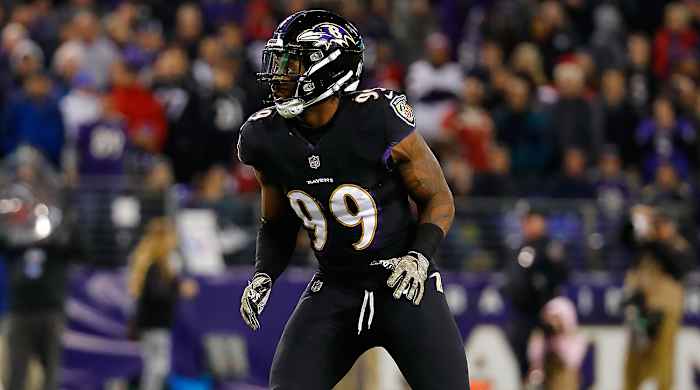
Matt Judon is one of the Ravens' younger players being pressed to step up this season.
Matt Patterson/AP
RAVENS REBUILD
Not everything’s new in Baltimore, but it feels like everything’s about to be. Ozzie Newsome is going to hand over the GM reins to Eric DeCosta in six months. Lamar Jackson was drafted as Joe Flacco’s successor. And out on the practice field, there’s an absolute armada of young players being pushed into bigger roles.
A new day is coming in Baltimore in some regards. In others it’s already here.
“It has to be, because those are the guys who are gonna play,” Ravens coach John Harbaugh said, in a quiet moment after Sunday’s practice. “[Third-year linebacker Matt] Judon, he’s starting, and [second-year LB Tyus] Bowser’s right there with him. So they’re taking the reps. … We’ve had 30 draft picks the last three years. That’s phenomenal. That’s a lot of draft picks. So that’s the Ravens now, that’s who we are. It’s gonna be fun to see them play.”
Of those 30 draft picks, a staggering 29 are still on the roster (ex-Navy QB Keenan Reynolds is the exception), and while I was out there, it seemed like they were all over the place. Marlon Humphrey (first round, 2017) and Tavon Young (fourth round, 2016) in the secondary. Bowser (second-round, 2017), Judon (fifth, 2016) and Tim Williams (third, 2017) up front. Jackson (32nd overall this year) taking snaps. And that’s without LT Ronnie Stanley and TE Hayden Hurst, two first-rounders who missed the two-plus hour practice.
The implication is clear—if the Ravens are going to break their three-year playoff drought, all those guys have to pull their weight. And if Harbaugh’s right, the difference is going to come in the details.
In his first five years—and in six of his first seven—Harbaugh’s teams not only made the playoffs but also advanced in them, and did it largely on the strength of their playmakers. Conversely, as he sees it, during 8–8 and 9–7 seasons the last two years, Baltimore missing the playoffs came down to plays the Ravens didn’t make.
Le’Veon Bell Is Right, and So Are the Steelers
In his young players, Harbaugh sees athletes. The defense, indeed, looks faster, and the offense more versatile. The question then becomes whether those athletes can be playmakers on the NFL level—and make the difference on game-swinging plays that the Ravens haven’t made the last couple years.
“That’s unanswerable, except to the degree that you know it when you see it,” Harbaugh said. “I feel like different years, going into the season, I’ve been concerned about who’s gonna make plays for us. Who’s gonna move the chains? Who’s gonna make the contested catches? We had Steve Smith making plays, and I knew he was gonna make plays, and he did.
“Other guys, you wanted them to, and maybe they didn’t make those plays and that’s why you didn’t win those games when it comes right down to it. That’s the players, that’s what keeps guys in the league, making plays to win games.”
So how much pressure is on everyone to make that happen, given that this is the franchise’s longest playoffless run since it won its first Super Bowl in 2000? Harbaugh’s answer: “Guys always feel pressure in this league. From a competition standpoint, it doesn’t get any better than the National Football League.”
He then added this: “I think we’re going to be really good. I feel great about it. … Basically the team has been remade. So let’s let these guys play and see how they do—put them out there, coach them up, and see how they do.”
Of course, 30-somethings like Flacco, Terrell Suggs, Eric Weddle, Marshal Yanda and Jimmy Smith are still around, and they’ll have their roles. But they’ll also have a lot of help, if Harbaugh has his way.
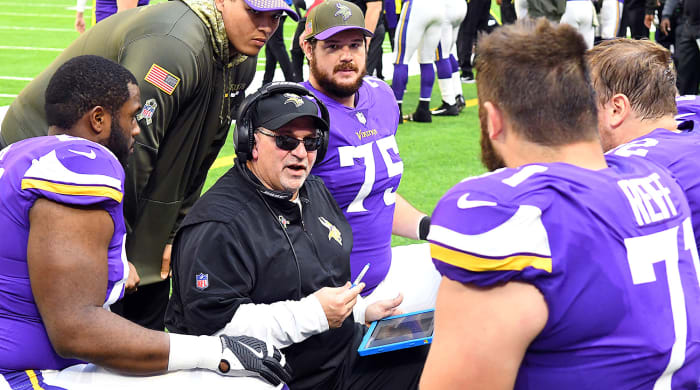
Tony Sparano always wore sunglasses, even inside, due to light sensitivity as a result of an accident suffered while working at a fast-food restaurant when he was a teenager.
Nick Wosika/Icon Sportswire via Getty Images
REMEMBERING TONY SPARANO
I first heard of Tony Sparano when I was 17 years old. He was the head coach at the University of New Haven, and he was recruiting a couple of my teammates—Brian Shay and Joe Bernotas—at Lincoln-Sudbury, outside of Boston. A decade later, when I got a job covering the Cowboys for the Dallas Morning News, I brought that up to Sparano.
He remembered everything about my teammates, who wound up only playing a year for him at the DII school (Sparano was off to the NFL as an offensive quality control coach for the Browns in 1999). After I was around him in Dallas, where he was an assistant for five seasons in the 2000s, it became abundantly clear why he had that kind of recall on a couple kids he had coached years earlier: The players mattered to him, and people mattered to him. Anyone could see that on a daily basis.
Like everyone else, I was stunned to hear of his death on Sunday. ESPN’s Chris Mortensen reported that Sparano went to the hospital on Thursday complaining of chest pains, and after evaluations he was sent home the following day. On Sunday his wife, Jeannette, found Sparano unconscious as they were getting ready to go to church on Sunday morning.
If you wanted to know what kind of person Sparano was, the outpouring of condolences from the NFL community explains it.
In the immediate aftermath, I reached out to former NFL linebacker Kevin Burnett, who was with Sparano for four years in Dallas and was one of a parade of former Cowboys who found their way to the Dolphins after Sparano became head coach in Miami.
“This one hurts,” Burnett said. “He was a real coach—he was real. I don’t know if I can take that word, ‘real,’ and explain how Tony was that. But he was a relatable coach—everything he said, you could relate to it. And he met you at eye level. He never talked down to you. You knew he respected you, and because of that he commanded respect back without having to ask for it.”
Tony Sparano Remembered for His Tough-But-Caring Attitude on the Field
Burnett recalled Sparano’s favorite saying—fair but not equal—as a tenet of the program they were working to build in Miami. All the same he remembers what happened when the wheels came off in the 2011 season.
Brian Hartline, who played for Sparano from 2009 to ’11, remembers that unforgettable season too. Dolphins owner Stephen Ross flirted with hiring then-Stanford coach Jim Harbaugh that January, only to retain Sparano. It created plenty of awkwardness, and it didn’t help that the team started 0–7. The players could have folded up their tents, but they didn’t because Sparano wouldn’t let it happen.
“He was second to none,” Hartline said. “It was a circus. And he was consistent. Truthfully, knowing how tough a situation it was, he was unbelievable. He was only worried about the players, the team. It was very genuine.”
Every year at the end of the season, Sparano would open his home for players to come by. After his firing, he did the same, and, as Hartline remembers it, almost the whole team showed up.
“He was who he was,” Hartline said. “There were no other motives with him, no back-door dealings. Anything he’d tell the GM, he’d tell you. There was just great clarity there. He was thoughtful. He was very direct, very authentic, very relatable.”
Those bonds lasted too. Burnett shot Sparano a text at 5:21 p.m. on Father’s Day, a few weeks back, and had a response back 17 minutes later, even though they hadn’t talked in a while. Another example, as Burnett saw it, of Sparano being real.
Hartline, now a coach himself at Ohio State, actually was at Vikings OTAs in June to see his old receivers coach, Darrell Hazell, and he and Sparano caught up there. A couple weeks later, on June 16, the two had a quick text exchange. The last thing in Hartline’s phone from Sparano reads: “Same here, pal. Let me know if I can help in any capacity. I’m always available.”
Sparano’s wife and his whole family are in our thoughts.
ISLAND TIME
For then-Jets GM Mike Tannenbaum, maybe the first indication that Darrelle Revis was different came with a phone call from the Pittsburgh airport in 2007. His assistant GM, Terry Bradway, had been at Revis’s Pro Day at Pitt. Going into the NFL draft, there were questions about the level of competition Revis had faced in the Big East, but a spectacular workout made all of those questions melt away.
At the time the Jets, who had the No. 25 pick in the first round, had a big need at cornerback and were considering Revis, along with Texas’s Aaron Ross and Michigan’s Leon Hall. But Bradway’s intuition became Tannenbaum’s determination to get aggressive, and move up for the singular talent.
“He won’t be there at 25,” Bradway told Tannenbaum.
Last week, 11 years later, Revis retired as one of the game’s all-time greats at his position. I’m not a Hall of Fame voter, and I know how tough the calls they have to make are, but I’d be pretty surprised if he doesn’t get in on his first try in 2023. You won’t be surprised to hear, then, that I didn’t get any disagreement from the man who drafted him when we spoke the other day.
“I thought he was an all-time great,” Tannenbaum, now the Dolphins EVP of football operations, said. “But more than that, he was a great competitor who really practiced hard, and did all the little things to make himself one of the best corners. I always really admired his competitiveness. He didn’t want to lose at anything. To me, that’s a big part of his legacy.”
We all saw that on a play-to-play basis during Revis’s prime, as he’d grind All-Pro after All-Pro into game-day irrelevance. I’d argue, in fact, that it’d be hard to play any position better than the level Revis at which was playing corner from 2009 to ’11.
Darrelle Revis Changed the NFL as Both a Player and a Businessman
Let’s look back at Revis with Tannenbaum, who was with him for six years. Here are a few of his memories …
The trade. Tannenbaum didn’t want to leave much to chance, so he tapped into a strong relationship to set up his move up the draft board—calling Panthers GM Marty Hurney about the No. 14 pick. Tannenbaum told Hurney there was one player they were looking to move up for, promised he wouldn’t drop the price they discussed on the clock and asked that Hurney not raise it on the clock. Parameters were agreed to the night before: The Jets would send the No. 25 pick, and second- and fifth-rounders to Carolina for the No. 14 pick and a sixth-rounder. Revis was there at 14. The deal was done.
The revelation. As Tannenbaum describes it, he, Bradway and Eric Mangini got an idea of what they were getting on the first day of the Jets’ rookie camp that May at Hofstra. “He was really competitive in every drill at practices, that’s really what stood out to me more than anything,” Tannenbaum said. “He was always at the front of the line, always competing, it was never too big for him. I think he wanted to show people how good he was in practice from Day 1.”
The negotiations. A couple months after that practice, Revis was a training camp holdout, and that was a harbinger for things to come. There weren’t very many offseasons where his contract wasn’t a topic of conversation. Tannenbaum concedes now that it wasn’t ideal, but it was easier to swallow because the Jets knew his play wouldn’t fall off after he got paid: “He had an unreal desire to be great. That was just his DNA. He was like that, I’m telling you, the whole time I was around him. That never changed. And he wanted to be great for all the right reasons.”
The diner. Viewers of Hard Knocks got a glimpse of one of the more unique negotiating venues of Revis’s 2010 negotiation—the Roscoe Diner in Roscoe, N.Y., served as a meeting point between New York City and Jets training camp in Cortland, N.Y., and Tannenbaum still hears about it today. “I’m a little disappointed I don’t get royalties from the Roscoe Diner,” Tannenbaum joked. “Apparently people who go to Syracuse University from the metropolitan New York area, the tri-state area, I think it’s become a very well-traveled place, I’ve been told that.”
The end isn’t pretty for many players, and it wasn’t for Revis. There were questions about his conditioning during his final season as a Jet in 2016, and last year’s stretch run with the Chiefs ended with questions about the effort (or lack thereof) he made to run down Derrick Henry in a playoff loss to the Titans.
But no one should forget what he was over the first nine years of his career—maybe the greatest Jet ever, one of the two or three best players on a champion Patriots team, and, for a time, as good a man-to-man cover guy as the NFL has ever seen.
… OF THE WEEK
Tweet
Let’s see how many people take this one the wrong way.
Video/YouTube
Sometimes it’s hard to pick a video of the week. Not this week.
Quote
“You earned it, man. You made it real easy to go to bat for you.”
— Rams coach Sean McVay to Brandin Cooks, in a video posted by the team in the wake of Cooks signing a five-year, $81-million extension.
This may seem silly just because Cooks has only been with the Rams for a few months—and hasn’t even strapped on shoulder pads for the team yet. But there’s truth to it. His work ethic and practice habits stood out to the staff there as much as his speed did in the spring, which is one reason why the team was cool to do this deal now.
Meme
We were overdue for someone to call his shot on a 16–0 season. So thank you, Malik Jackson.
S/O to …
Bucs WR Mike Evans for giving $11,000 to the family of a shooting victim this week. Gregory Hill was shot by a sheriff’s deputy in 2014, and his family filed a wrongful death lawsuit in the aftermath. A Florida judge found the department 1% responsible, and awarded $1 to each of Hill’s three children, and $1 to the family for funeral expenses. Evans asked the family how he could help through Twitter and was shown to a GoFundMe page, where he dropped five figures.
TEN TAKEAWAYS
1.The hysteria surrounding the NFL’s now-frozen national anthem policy last Thursday only goes to prove what most people knew coming out of the owners’ May meeting—the policy was a poor way to try to move the focus back to football. There was always going to be scrutiny over how the individual teams established policies, so the Dolphins’ situation was just one of 32 news cycles to come. On top of that, the media would take sideline attendance during every game starting in the preseason to see which players stayed in the locker room, likely drumming up more news. That’s without the potential that the president could ignite another controversy by saying something similar to what he said last September. It’s good that the NFL and the NFLPA are talking now, and I’m told they’ve been doing so since before the July 4 holiday, with players, owners, commissioner Roger Goodell, and NFLPA executive director DeMaurice Smith and president Eric Winston directly involved. There’s been at least one in-person meeting, and my understanding there’s a good chance for another one this week. Hopefully they can work something out that works for everyone—even if the ship has sailed on the easy answer, which was to do nothing back in May.
2. A little bit of house-cleaning here: Only three of the top nine picks from April’s draft have signed their rookie deals, and that’s counting Giants RB Saquon Barkley, who got his deal done on Sunday. That puts this class behind others that signed quickly under the 2011 CBA rules, which give little wiggle room when it comes to negotiation on rookie deals. So what’s the holdout? Offset language (which only comes into play if a player is cut in his first four years) is one battleground, as it has been for a while with top picks. Another this year, I’ve been told, is language that voids guarantees in contracts—like a suspension or arrest might. I understand if this seems silly to fans, but there are larger motivations at work: Agents want to win in these situations because it helps them to recruit, and teams wants to win to establish precedent.
3. While in Bourbonnais, I got the sense that the Bears think Mitchell Trubisky is a great fit for the offense Nagy is building. The ideal is to have a quick-twitch athlete who can throw on the run, so Trubisky has the prerequisites in spades. Guard Kyle Long explained it like this: “You see what you can do with a guy who can threaten the edge and be creative in the pocket. There’s a guy up North, No. 12, who does that well, and he’s made a pretty good career for himself. And we hope that’s the way things can progress.” The guy up north, in case you don’t know, is Aaron Rodgers.
Mitchell Trubisky Reflects On His Rookie Season and His Lessons Learned
4. There’ll be plenty of people watching where Lamar Jackson lines up—at positions other than quarterback—in the preseason. But it seems he’s impressed the coaches with his early work in Baltimore at quarterback, too. Two things have stood out, from what I could gather. First, work on his mechanics has helped to tighten his throws. He’s still got a ways to go there, and I saw some flutter on Sunday, but there were a few passes he let go down the field that couldn’t have looked prettier. Second, he’s impressed the staff with his field vision, which is the kind of thing that’s hard to teach.
5. Derek Carr told Jim Rome something about Raiders new head coach Jon Gruden this weekend that got my attention: “Everything I dreamed of and thought of about him, it’s been all that and then some. We’re so similar.” That should be music to Raiders’ fans ears. Most people in the building last year believed that losing the hard-driving style of ex-offensive coordinator Bill Musgrave, and the tension it created, showed up in Carr’s play. And some wondered how he’d react to being re-introduced to that kind of coach with Gruden’s arrival. Looks like so far, so good.
6. I don’t think the Buccaneers’ decision to leave Jameis Winston out of a big promotional campaign last week should be ignored. A decision like that is made at the highest levels of an organization, and it probably reflects the feelings of those in ownership about the position Winston’s behavior and resulting suspension put the team in.
7. The league has to decide whether or not to put Bills RB LeSean McCoy on the commissioner’s exempt list due to the ongoing investigation into the incident in Georgia earlier this month. This type of situation is why the commissioner’s exempt list exists—taking a team and a player out of a potentially awkward situation/decision while a case is being investigated.
8. It’s great news that Colts GM Chris Ballard declared Andrew Luck “good to go” last week, because that’s a bridge the team hasn’t crossed since he first got hurt. So what’s Luck been doing? He’s been throwing a weighted ball for months, and has been throwing footballs since the Colts finished minicamp. One source said the progress has been “steady.” Later this week we’ll get to see for ourselves.
9. I view Terrell Owens’s decision to skip the Hall of Fame ceremony next week the same way I see Baker Mayfield’s decision to turn down an invite to the draft a few months back—it’s a great night recognizing accomplishment for these guys, and they should be free to spend it how they see fit. The Hall looks small for getting prickly over the situation.
10. Not sure if anything’s set in stone yet, but it looks like the Cardinals will run Sam Bradford with the first team and Josh Rosen with the second team early in camp, and give Bradford days off during which Rosen will get first-team reps. The chase to start at quarterback in Arizona should be interesting.
OFF-FIELD ISSUES
1. I missed the end of the British Open while out at Ravens practice, but it was pretty awesome to have Tiger Woods in contention on Sunday. Here’s hoping we get that again, with Jordan Spieth and Rory McIlroy there as well, at the PGA next month.
2. I walked into the men’s room off the lobby at the Inner Harbor Marriott late Saturday night, and immediately had an Orioles fan talking my ear off about the deal sending Manny Machado to the Dodgers. Apparently, people there aren’t enthusiastic about the guy who owns the team.
3. People are just fake upset about these LeBron James murals being defaced, right? (Also, read my buddy Tania Ganguli’s story from Sunday’s L.A. Times on the Lakers’ pursuit of LeBron. It’s worth your time.)
4. I don’t know if Kawhi Leonard is going to consider staying in Toronto, but I bet he’ll wind up liking it a lot more than people think.
5. Did Jimmy Garoppololose a bet?
FIVE-DAY FORECAST
Get ready to hear about the arrivals (or non-arrivals) of these six players at their respective training camps: Rams DT Aaron Donald, Raiders DE Khalil Mack, Falcons WR Julio Jones, Titans OT Taylor Lewan, Cardinals RB David Johnson and Seahawks S Earl Thomas. That’s more potential holdouts than we’ve seen on the doorstep of camp in a long time, and there’s an interesting reason for it: The gap between what quarterbacks make and what everyone else makes keeps growing.
This offseason, quarterbacks broke the $30 million per year barrier before any player at any other position got to $20 million per. The league’s 18 highest-paid players are quarterbacks. And the highest-paid non-quarterback (Von Miller) is making an average per year of 63.4% of what the top quarterback (Matt Ryan) is getting. That number was 86% when Ndamukong Suh broke the bank in 2015.
This, of course, reflects the importance of quarterbacks in the NFL in 2018. But it’s not hard to see why players are other spots aren’t pleased with how fast the divide has grown.
• Question or comment? Email us at talkback@themmqb.com.


































